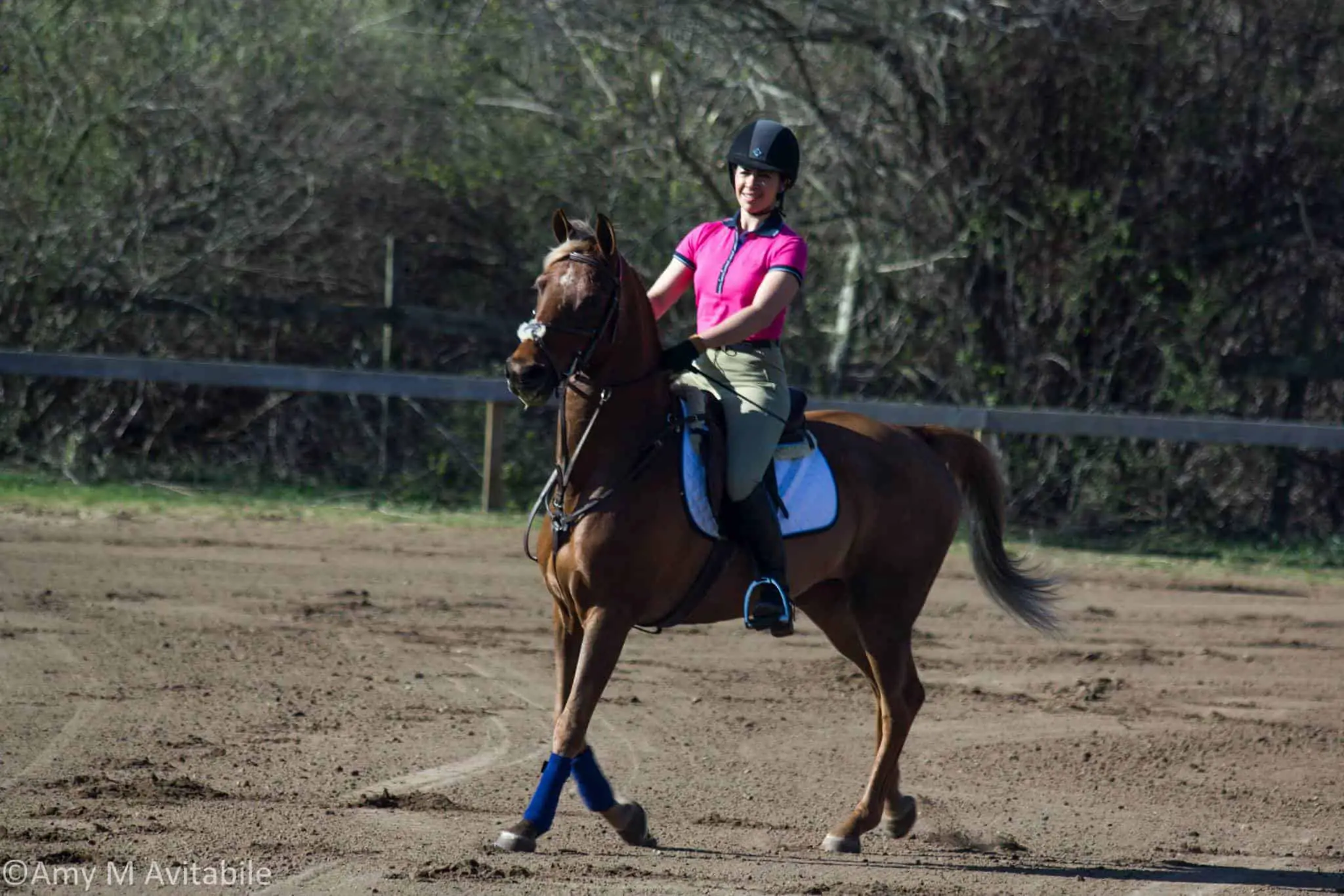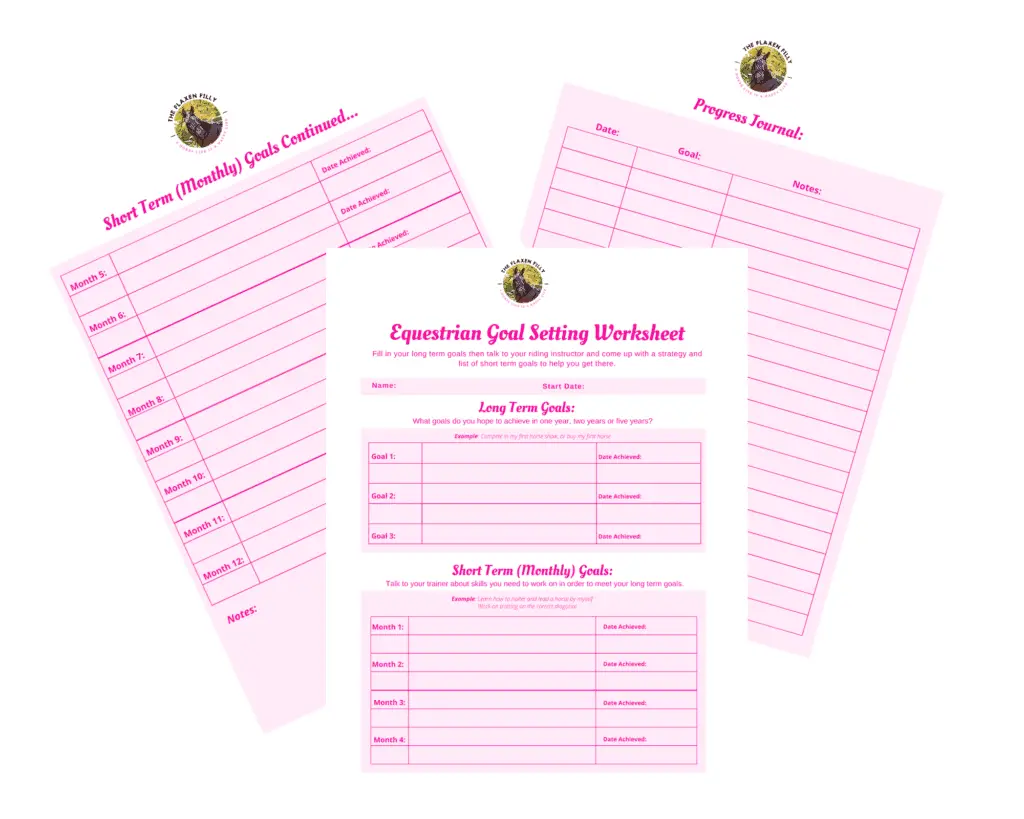For beginner equestrians one of the most dreaded lessons to learn is how to ride without your feet in the stirrups. No matter how much you may love horses and riding you’re bound to feel uneasy about this stage of your riding. Riding without stirrups is a necessary evil. Preparing ahead of time could prevent you from an unfortunate accident and possible injury in the future. If you ride long enough your instructor will undoubtedly introduce this practice at some point.
Here are some tips to help you get started safely and to ease your nerves about riding without stirrups.
Why Equestrians Need To Learn To Ride Without Stirrups
You may be asking yourself, why on earth do I need to learn to ride without stirrups? The stirrups are on the saddle for a reason so why subject myself to anxiety, discomfort and physical strain?
Well, here’s the obvious answer. You need to practice riding without stirrups so you are prepared in the event you lose your stirrup(s) while riding. Learning how to keep riding instead of panicking when you lose a stirrup during your jumper course or out on the trail can literally save your life.
And, secondly, riding without stirrups will make you a better rider. There are many benefits of practicing without stirrups but it’s important to take it one step at a time.
If you want to read more on this topic, check out another article I wrote where I share more detail.
Why You Should Participate In No Stirrup November
Test Your Horse’s Breaks
First and foremost, if you plan to be in any situation where you could potentially lose your balance, it’s important to know you’re on a horse that will stop easily.
And as an equestrian, you may frequently find yourself losing your balance even if only for a split second. Riders of all levels lose their balance from time to time.
The truth is, it happens all the time. Often, novice riders are even unaware that they lost their balance by falling behind the motion or leaning heavily on the horse’s neck.
Before you drop your irons for the first time, practice asking your horse to halt and stand still. You can try asking for the halt from a walk or trot. And, to emphasize to your horse that you truly want to stop, stand still for at least a few seconds before asking your horse to move forward again.
If you’re new to riding, here are some tips on asking for the halt.
Try not to yank the reins as this will annoy your horse and may cause you to lose your balance. Start by exhaling and relaxing your body. Next use a verbal command such as whoa in a low, calm and firm voice to alert the horse that you’ll be stopping. Many well trained horses will stop before you even pull the reins if you sit correctly and lower your energy. Next, stretch your heels down and sit in the saddle and bend your elbows to pull your reins.
Don’t lean too far back or your seat will drive the horse forward.
Try to pull your reins slowly enough that you don’t jerk them. At the same time, do not release your hold on the reins until the horse has stopped completely. Once the horse has stopped, release the rein pressure on his mouth to let him know he has responded correctly.
Practice Dropping And Picking Up Stirrups
In addition to being able to stop the horse, the next crucial skill you will need to learn before you ride without your stirrups is to pick them back up using only your feet. If the horse won’t stop and you fear losing your balance, it’s comforting to know that you can simply put your feet back in your stirrups.
However, this is not as easy as it is simple. You won’t have the ability to just lean over and use your hand to help you and thus you need to learn how to drop and pick up your stirrups quickly and smoothly without losing your balance.
A good exercise to help you practice this skill is to start at the halt. Drop one stirrup and then pick it back up. Once you can find your stirrup quickly and easily, try it with your other foot. Next, you will need to try this exercise at the walk, then you can progress to dropping both stirrups at the same time. When picking your stirrups up again, it is usually easier to pick up one at a time.
Once you have mastered the step above, try dropping one stirrup at a time at the trot and see if you can pick it up again within a couple of strides. And, be careful not to kick your horse into a faster trot while you are searching for your stirrup.
Learning this skill can take several lessons so be patient if you find you’re unable to do it on the first try.
Changing Speed Within The Gait
Another way to practice keeping your balance before you ditch your stirrups all together is to change your pace within the gait. Transitions within the gait are a great exercise for many reasons and for riders of all levels. Not only can your horse become more adjustable and supple but riders can improve accuracy, coordination and strength at the same time.
For the purpose of preparing to ride without stirrups the exercise is effective in helping you learn to adjust if your horse speeds up or slows down. Often times beginner riders lose their rhythm and have a difficult time maintaining their tempo for long periods of time. So, if you practice intentionally changing speeds you are less likely to become fearful and tense. You will condition your body and muscle memory to adapt to changes in speed before it happens by accident making you better equipped to ride through future challenges.
Check out some of my favorite riding gear here:
Exercises At The Halt
There are several ways to practice riding without stirrups safely even at your very first riding lesson. One way is to build up core and leg strength at the halt. You can even have a handler on the ground hold the horse still to prevent a sudden movement.
While at the halt take your feet out of the stirrups and try to point your toes up, then down and roll your ankle in a circle.
Next you can try sitting in your half seat at the halt which is incredibly difficult. Forward motion actually makes it easier to stay out of the saddle when riding in two-point. Sitting in two-point at the halt will certainly leave you feeling like you went to the gym.
Lastly, you can try posting at the halt without stirrups to prepare yourself for learning to trot without stirrups. By doing these exercises at the halt your instructor can help you position your leg correctly and explain exactly what she expects you to do without putting you at risk of a fall.
Start Slowly & Work In Short Sessions
Like any sport, becoming proficient takes time and consistency. And, similar to other sports, horseback riding can be dangerous. Pushing yourself to try a new skill beyond your capability and limits without working up to it first is extremely risky. At best your pride may be wounded when you realize you’re not quite as experienced as you thought. Worst case scenario, you take a hard fall. Neither is ideal.
The best way to ride without stirrups safely is to start in very short increments and in a controlled environment. If you’re comfortable only trying it at the walk first, that is ok. When you are ready to progress to riding without stirrups at the trot and canter don’t try to complete your entire ride without stirrups. The first time you trot without stirrups, try dropping your stirrups for just a couple of steps and picking them back up again. Or if needed, stop the horse and then pickup your stirrups.
This is not a new tactic and works well for learning to post the trot, sit the trot and canter for the first time.
Getting Assistance From Someone On The Ground
As I mentioned above, another key to staying safe is to try new skills in a controlled environment. When you’re first learning to trot or canter your instructor likely had you ride on a lunge line. This way, your trainer was able to help you manage the horse so you could focus on yourself.
Similarly, one way to keep a controlled environment is to only try new skills when your instructor is present.
For example, let’s say you started learning to jump recently and have only jumped a horse once or twice. But, you also lease a horse and ride outside of your lessons, you shouldn’t be jumping the horse you lease.
At least not yet.
Your instructor likely advised you to only jump during your lessons until you become competent enough to practice on your own.
In most barns, instructors do not allow students to try out new skills without being in a lesson. This goes for jumping, cantering, trail riding, trying a new horse, riding without stirrups etc.
So the take away here is, just because you rode without stirrups for a few minutes in your lesson does not mean you are ready to ride without stirrups on your own.
The second way to maintain a controlled environment and safely try out a new skill is to ride on the lunge line. The benefit of riding on a lunge line is that if you lose your balance your instructor can safely help you stop the horse. This does not necessarily mean you will not fall off. Everyone does and it can even happen on the lunge line. However, riding on a lunge line significantly reduces your risk of injury as you learn how to balance without stirrups.
Try To Stay Relaxed
Fear and tension are your worst enemy when it comes to riding horses especially when you lose your stirrups. Try your best not to hold your breath and grip your legs in fear. The best way to stay balanced is to breath and try to go with the motion. Try not to grip and hold on for dear life.
If you’re having a hard time breathing and staying calm, try counting while you ride. And no, I don’t mean just counting to 100. Count the rhythm of the gait you’re riding and pay attention to the horse’s footfalls.
For example, if you are trotting, try counting one, two, one two. The trot is a two beat gait as I outlined in another post which you can read here.
Counting your rhythm will help you keep your horse at a consistent pace. Speeding up or slowing down frequently could cause you to lose your balance. Counting will also give you something to focus on other than your nerves.
Use A Neck Strap
A neck strap is a commonly used tool that can help riders to quickly re-gain their balance without pulling on the reins. Often times riders grab the reins and hold on tightly in an effort to balance in the saddle which is punishing to the horse’s mouth. Instead, just grab the neck strap, you’ll regain balance and you won’t annoy your horse!
There is no shame in riding with a neck strap! And, it can be helpful for you and beneficial for your horse.
Plus, you don’t necessarily need to use it but it’s a nice tool to have. If you choose to ride with a neck strap try not to use it the entire time you are riding. You can hold the neck strap while keeping your arms relaxed just in case you need it.
At the end of the day safety is of the utmost importance and a fall or close call could shatter your confidence. If you want to gain new skills and confidence along the way you need to have a clear plan.
Check out this free goal setting worksheet specifically designed for equestrians to help you do just that!
Download your FREE Equestrian Goals Worksheet and start achieving your goals today!
I hope you found this article helpful! If you did, please share it with your friends by saving the pin below!



